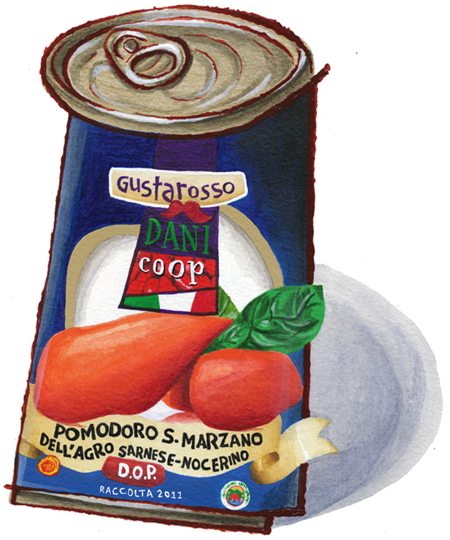Just like the flavor of wine varies based on its terroir, the flavor of tomatoes depends on its terroir, too. To grow the most flavorful tomatoes, you want super fertile soil and plenty of sunshine. Basically, you want to grow them at the foot of an Italian volcano. If you don’t live by the foot of an Italian volcano (or even if you do, but it’s not currently tomato season), then to get a really good tomato your best bet is to use one from a can.
Fresh food is better than canned, right? Not true.
Ten months of the year, the fresh tomatoes you can get at the grocery are pretty flavorless. However, a good canned tomato was picked in season at its peak ripeness and then minimally processed right away, locking in the fresh, rich summer flavor to last year round. And when we’re talking good canned tomatoes, it’s hard to beat a San Marzano grown just east of Naples.
“San Marzano” is the name of a tomato and a place.
The tomato is bright red and skinny, about two to three inches long and an inch wide. They have fewer seeds than other tomatoes. They have a delicate skin that peels off easily. And most importantly, they have a remarkably sweet flavor. They were first cultivated in the town of San Marzano sul Sarno, about half an hour east of Naples, under the shadow of Mount Vesuvius.
Folks have been canning tomatoes around San Marzano sul Sarno since the 1870s. In the last few decades, canned San Marzano tomatoes have become trendy with chefs. As the tomatoes gained notoriety people started growing them all over the world. There’s nothing inherently wrong with that—you could buy a packet of San Marzano seeds and grow San Marzanos in your own garden this summer. They’d be good. But they wouldn’t be quite the same as the ones grown by Mount Vesuvius. Just like chardonnay from California tastes different than chardonnay from France, tomatoes will taste different based on their terroir, too. The volcanic soil on the slopes of Mount Vesuvius is incredibly fertile, and it grows tremendously flavorful fruit and vegetables. And when you pair that soil with the hot, sunny summers of southern Italy, you’ve got the recipe for growing some of the most delicious tomatoes on earth.
In Europe, canned San Marzano tomatoes are protected by a DOP—that is to say, just like Champagne or Parmigiano Reggiano cheese, you can’t claim to sell San Marzanos unless you grow that exact varietal in the land around San Marzano sul Sarno, and you follow certain rules like picking the tomatoes by hand and peeling them before you put them in the tin whole. But in the US, we’re not bound by European law, and the result is that practically all of the tins labeled as “San Marzanos” on the American market aren’t actually the real deal ones grown in Vesuvian soil. If they’re grown somewhere else, it may say so in teeny-tiny writing hidden somewhere on the can. The real ones cost a bit more. But their flavor is remarkable.
San Marzanos shine when you use them in simple preparations.
Try smooshing the tomatoes with your hand, mixing them with a little salt and olive oil, then spreading that uncooked sauce on top of a pizza dough. Top it with a little mozzarella and then some fresh shredded basil just after it comes out of the oven, and you’ve got the perfect neapolitan pizza. Because there are so few ingredients, the flavor of the tomatoes is front and center.
Or, in the 20 minutes that it takes to boil water and cook pasta, heat a can of tomatoes on the stove with a clove or two of smashed garlic, a sprinkle of salt, and maybe a pinch of dried oregano to make the ultimate marinara. When the pasta is almost done, drain it and then toss it in the sauce on the stove. Give the whole thing a generous glug of good olive oil and serve immediately. Be sure you’ve got some bread on hand to use as scarpetti—little shoes—the word Italians use to describe scraping the last of the sauce off of your plate.

